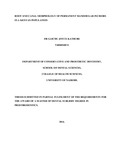| dc.description.abstract | Background: Knowledge of root and canal anatomy is essential in designing and preparing
access cavities that give straight line access to the main root canals. Thorough knowledge and
understanding of dental anatomy and variations in root and canal morphology of mandibular
incisors which include length, shape, position and number is important for favorable root canal
treatment.
Objective: To determine the root and canal morphology of permanent mandibular incisors in a
Kenyan population.
Study duration: The study was conducted for a period of three years, from 2011 to 2014.
Study Design: This was a descriptive cross sectional study.
Study area: The study was conducted in selected public dental institutions within Nairobi and its
environs namely Kenyatta National Hospital - Dental clinic, University of Nairobi - Dental
Hospital, Mbagathi District Hospital, Kiambu District Hospital, Thika Level Five Hospital,
Social League Dispensary, Gatundu District Hospital, Kajiado District Hospital, Machakos Level
Five Hospital, Ngong District Hospital and Mathari District Hospital.
Materials and methods: A total of 208 permanent mandibular incisors (124 lateral and 84
central) that conformed to the inclusion criteria were collected from the selected centres. The
teeth were washed in 3.85% m/v sodium hypochlorite (Reckitt Benckiser E.A Nairobi, Kenya) to
remove adherent tissue and then stored in labeled containers containing 10% formalin (ART- M3
Bonart, Taiwan). First, data was collected on root morphology by direct observation. Root length
was measured using a calibrated electronic vernier caliper. A standard clearing technique was
applied to determine the number of canals and canal configurations according to Vertucci’s
classification. A data collection form was used to record the findings for each tooth examined.
Data analysis and presentation: The data was stored, coded and analyzed using Statistical
Package for Social Sciences (SPSS Version 16, Illinois-Chicago). Obtained data was used to
calculate frequencies, means, chi-square and t-statistics of various variables and inferences were
drawn from the values obtained. The values obtained from inferential statistics were used to
compare results with those obtained in studies done in other populations. A value of P < 0.5 was
considered statistically significant. Results were presented in form of frequency tables and pie
charts.
Results: A total of 208 mandibular incisors (124 lateral and 84 central) were analyzed. All the
incisors had one root. Of the central incisors, 56 (66.67%) had curved roots while 86 (69.35%) of
lateral incisors had curved roots. Distal curvatures were the most prevalent.
The mean root lengths were 12.38 ± 0.244mm and 13.55 ± 0.4mm in central and lateral incisors
respectively..
Majority of central, 68 (80.5%) and lateral, 102 (82.26%) incisors had one canal at the floor of
the pulp chamber. Type I canal configuration was the most frequent in both central (71.43%) and
lateral (67.74%) incisors. Single apical foramina were the commonest in both central (88.1%)
and lateral (90.32%) incisors.
Conclusions: All central and lateral incisors had one root. Roots were mostly centrally located
and distally curved. Majority of teeth had a single canal at the pulpal floor and anatomical apex
and type one canal configuration was the most prevalent. Lateral canals, apical deltas and
intercanal anastomosis were uncommon in central and lateral incisors.
Recommendations:
There is need for investigation of a second canal and unusual canal morphology in permanent
mandibular central and lateral incisors during routine endodontic treatment. | en_US |
| dc.description.department | a
Department of Psychiatry, University of Nairobi, ; bDepartment of Mental Health, School of Medicine,
Moi University, Eldoret, Kenya | |

